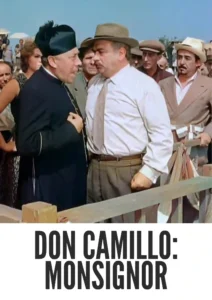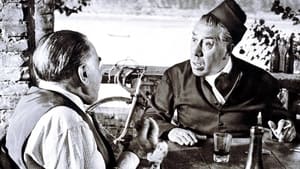Contact: info@alwanfilm.com
Video Sources 0 Views

Synopsis
Review: Don Camillo: Monsignor 1961 Colorized – A Study of Charm and Charisma in Color

Introduction
In the rich tradition of Italian cinema, few films capture the warmth, humor, and complexity of rural life quite like “Don Camillo: Monsignor 1961.” Directed by the esteemed Italian filmmaker Carmine Gallone, this film represents the continuation of the beloved Don Camillo series, offering audiences a delightful blend of comedy and drama. What sets this installment apart is its re-release in an early colored version, adding a fresh layer of visual appeal to a classic tale. In this article, we delve into the impact of colorization on “Don Camillo: Monsignor 1961” and examine its significance in the broader context of film history.
Check The Full Colorized Movies List
Check Our Colorized Movies Trailer Channel
Understanding Don Camillo: Monsignor 1961 Colorized – Director, Cast, and Genre
“Don Camillo: Monsignor 1961” is helmed by Carmine Gallone, known for his adept handling of comedy and drama. Gallone’s direction continues the engaging narrative established in the previous films of the Don Camillo series. The film features a stellar cast led by the incomparable Fernandel, who reprises his role as the eponymous Don Camillo. His portrayal of the fiery and endearing priest remains one of cinema’s most memorable performances.
The film also stars Gino Cervi as the Communist mayor, Peppone, whose rivalry with Don Camillo adds both conflict and comedic flair. Together, Fernandel and Cervi create a dynamic duo that embodies the spirit of rural Italy with charm and wit. The genre of “Don Camillo: Monsignor 1961” blends elements of comedy, drama, and satire, capturing the essence of life in post-war Italy with a light-hearted yet poignant touch.
Exploring the World of Don Camillo: Monsignor 1961 Colorized – Plot and Characters
“Don Camillo: Monsignor 1961” picks up where its predecessors left off, following the continuing adventures of Don Camillo, a Catholic priest with a penchant for getting into scrapes. This installment focuses on Don Camillo’s promotion to the role of Monsignor, a position that brings both prestige and new challenges. The narrative deftly explores the tensions between Don Camillo and the town’s Communist mayor, Peppone, as they navigate the complexities of modernizing rural Italy.
Key moments include Don Camillo’s humorous struggles with his new responsibilities, his interactions with the eccentric townsfolk, and his ongoing battles with Peppone. The film’s rich character development and engaging storyline make it a delightful watch, offering insights into the social and political landscape of the time.
The Art of Film Colorization
Film colorization involves the process of adding color to black and white footage, a technique that has evolved significantly over the years. Early colorization efforts were often rudimentary, involving hand-tinting or basic color overlays. However, advancements in technology have made it possible to achieve more sophisticated and nuanced color effects.
For “Don Camillo: Monsignor 1961,” the colorized version provides a new dimension to the film’s visual appeal. The vibrant hues of rural Italy come to life, enhancing the charm and authenticity of the setting. The process of colorization not only revitalizes the film but also offers a fresh perspective on its aesthetic and emotional impact.
Early Colored Films: A Brief History
The history of color in cinema is marked by several key milestones, from the early experiments with hand-painted frames to the advent of Technicolor. Early colored films, such as “The Toll of the Sea” (1922) and “Wings” (1927), showcased the potential of color to enhance storytelling and visual appeal. Technicolor, in particular, revolutionized the industry, offering a more vibrant and immersive experience for audiences.
As technology continued to advance, colorization became more sophisticated, allowing filmmakers to achieve greater levels of detail and accuracy. The early colored version of “Don Camillo: Monsignor 1961” represents a continuation of this tradition, blending classic storytelling with modern visual techniques.
Don Camillo: Monsignor 1961 and Its Early Colored Version
The decision to release “Don Camillo: Monsignor 1961” in an early colored format adds a new layer of vibrancy to the film’s already rich visual tapestry. The colorization process brings out the lush landscapes, the vivid costumes, and the intricate details of rural Italy, enhancing the film’s overall charm.
For many viewers, the colorized version of “Don Camillo: Monsignor 1961” offers a renewed appreciation for the film’s visual aesthetics. The vibrant colors breathe new life into familiar scenes, providing a fresh perspective on the film’s beloved characters and settings.
The Debate Over Film Colorization
The colorization of classic films is a topic of ongoing debate within the cinematic community. Proponents argue that it revitalizes older films, making them accessible and appealing to modern audiences. Detractors, however, raise concerns about the impact on the film’s original artistic vision and historical context.
In the case of “Don Camillo: Monsignor 1961,” the colorized version invites viewers to reconsider their perceptions of the film’s visual style. While some may appreciate the enhanced vibrancy, others may prefer the original black and white presentation for its historical authenticity and stylistic integrity. The debate highlights the complex interplay between tradition and innovation in film preservation.
Examining Don Camillo: Monsignor 1961 as an Early Colored Film
The early colored version of “Don Camillo: Monsignor 1961” offers a unique perspective on the film’s visual storytelling. The colorization enhances the film’s setting, bringing out the rich textures of rural Italy and highlighting the vibrant personalities of its characters.
However, the colorization also raises questions about the balance between artistic reinterpretation and historical accuracy. For some viewers, the addition of color may enhance the film’s appeal, while for others, it may detract from the original aesthetic. The colorized version of “Don Camillo: Monsignor 1961” thus represents both an opportunity and a challenge, offering a fresh perspective while navigating the complexities of film preservation.
Influence and Legacy: Don Camillo: Monsignor 1961 Colorized’s Impact on Cinema
“Don Camillo: Monsignor 1961” continues the legacy of the Don Camillo series, which has left a lasting impact on Italian cinema. The film’s blend of humor, drama, and social commentary has resonated with audiences for decades, establishing it as a classic of Italian cinema.
The influence of the Don Camillo series extends beyond Italy, with the films inspiring remakes and adaptations in various international markets. The enduring appeal of Don Camillo and Peppone reflects the universal themes of conflict, camaraderie, and community that are central to the series.
Director’s Cinematic Legacy: Beyond Don Camillo: Monsignor 1961 Colorized
Carmine Gallone’s directorial career spans several decades and includes a diverse range of films, from historical dramas to comedies. His work on the Don Camillo series is particularly noteworthy, showcasing his ability to blend humor and social commentary with engaging storytelling.
Gallone’s cinematic legacy extends beyond the Don Camillo films, with contributions to Italian cinema that reflect his versatility and creativity. His films continue to be celebrated for their charm, wit, and insight into Italian life and culture.
Themes Explored in Don Camillo: Monsignor 1961 Colorized
“Don Camillo: Monsignor 1961” explores themes of faith, friendship, and social change, reflecting the complexities of post-war Italian society. The film’s portrayal of Don Camillo and Peppone’s ongoing rivalry highlights the tensions between tradition and progress, while also celebrating the enduring bonds of community.
The film’s humor and warmth offer a poignant commentary on the challenges of modernizing rural life, capturing the essence of Italian resilience and solidarity. Through its engaging characters and memorable scenes, “Don Camillo: Monsignor 1961” offers a rich tapestry of themes that continue to resonate with audiences.
Reception and Controversy Surrounding Don Camillo: Monsignor 1961 Colorized
The release of “Don Camillo: Monsignor 1961” in its early colored version has generated both praise and controversy. Critics and audiences have responded to the film’s enhanced visual appeal, with some applauding the renewed vibrancy and others expressing concerns about the impact on the film’s original aesthetic.
The debate over the colorization of “Don Camillo: Monsignor 1961” reflects broader discussions within the film community about the balance between preservation and innovation. While the colorized version offers a fresh perspective, it also prompts questions about the preservation of artistic integrity and historical authenticity.
Where to Watch Don Camillo: Monsignor 1961 Colorized Online
For those interested in experiencing “Don Camillo: Monsignor 1961,” the film is available on various streaming platforms, offering accessibility to a global audience. Whether in its original black and white format or the early colored version, the film remains a beloved classic of Italian cinema.
FAQs About Don Camillo: Monsignor 1961 Colorized
Q: Is “Don Camillo: Monsignor 1961” part of a series?
A: Yes, “Don Camillo: Monsignor 1961” is the third film in the Don Camillo series, following “Don Camillo” (1952) and “Don Camillo e l’onorevole Peppone” (1955). The series continues the adventures of Don Camillo and Peppone, exploring their humorous and heartfelt interactions.
Q: What is the significance of the colorization of “Don Camillo: Monsignor 1961”?
A: The colorization of “Don Camillo: Monsignor 1961” adds a new visual dimension to the film, enhancing its appeal and bringing the vibrant settings and characters to life. While some viewers appreciate the added vibrancy, others prefer the original black and white presentation for its historical and stylistic authenticity.
Q: Who are the key characters in “Don Camillo: Monsignor 1961”?
A: The key characters include Don Camillo, portrayed by Fernandel, and Peppone, played by Gino Cervi. Their ongoing rivalry and camaraderie drive the film’s humor and drama, reflecting the social and political dynamics of post-war Italy.
Conclusion
“Don Camillo: Monsignor 1961” remains a charming and insightful entry in the beloved Don Camillo series, capturing the essence of Italian rural life with humor and heart. The film’s early colored version offers a fresh perspective on its visual style, enhancing its appeal while sparking debate about the impact of colorization on cinematic heritage.
As we reflect on the enduring legacy of “Don Camillo: Monsignor 1961,” it is clear that its blend of comedy, drama, and social commentary continues to resonate with audiences worldwide. Whether experienced in its original black and white format or the vibrant colorized version, the film remains a testament to the enduring power of storytelling and the rich tradition of Italian cinema.












